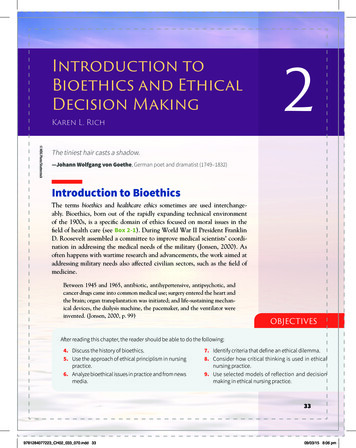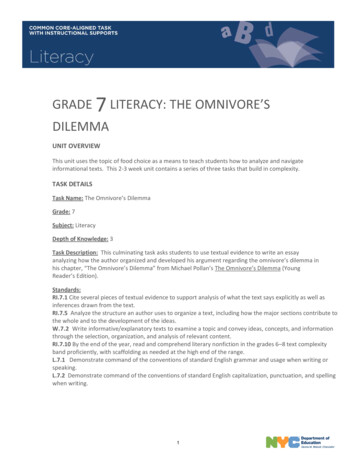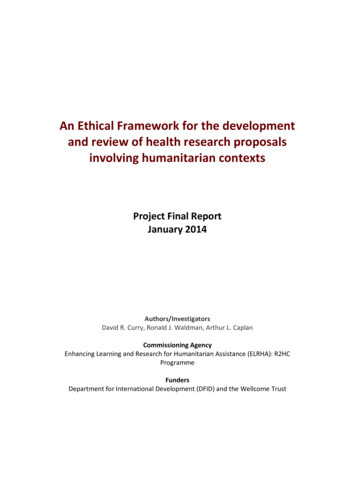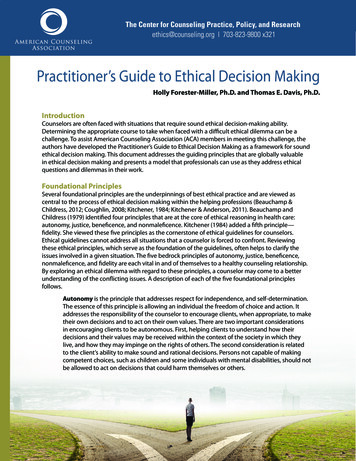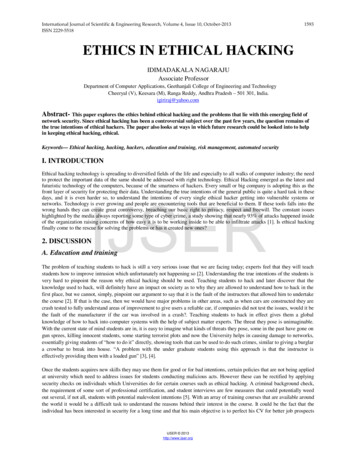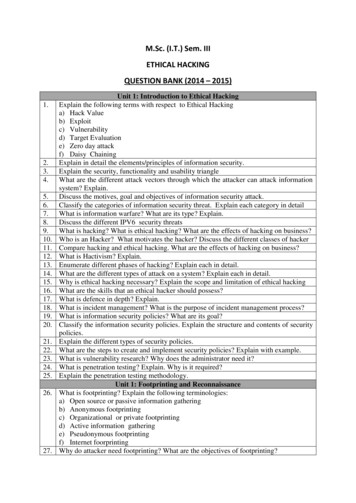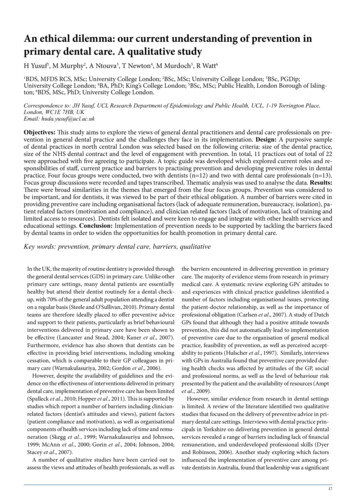
Transcription
An ethical dilemma: our current understanding of prevention inprimary dental care. A qualitative studyH Yusuf1, M Murphy2, A Ntouva3, T Newton4, M Murdoch5, R Watt6BDS, MFDS RCS, MSc; University College London; 2BSc, MSc; University College London; 3BSc, PGDip;University College London; 4BA, PhD; King’s College London; 5BSc, MSc; Public Health, London Borough of Islington; 6BDS, MSc, PhD; University College London.1Correspondence to: JH Yusuf, UCL Research Department of Epidemiology and Public Health, UCL, 1-19 Torrington Place,London, WC1E 7HB, UKEmail: huda.yusuf@ucl.ac.ukObjectives: This study aims to explore the views of general dental practitioners and dental care professionals on prevention in general dental practice and the challenges they face in its implementation. Design: A purposive sampleof dental practices in north central London was selected based on the following criteria: size of the dental practice,size of the NHS dental contract and the level of engagement with prevention. In total, 11 practices out of total of 22were approached with five agreeing to participate. A topic guide was developed which explored current roles and responsibilities of staff, current practice and barriers to practising prevention and developing preventive roles in dentalpractice. Four focus groups were conducted, two with dentists (n 12) and two with dental care professionals (n 13).Focus group discussions were recorded and tapes transcribed. Thematic analysis was used to analyse the data. Results:There were broad similarities in the themes that emerged from the four focus groups. Prevention was considered tobe important, and for dentists, it was viewed to be part of their ethical obligation. A number of barriers were cited inproviding preventive care including organisational factors (lack of adequate remuneration, bureaucracy, isolation), patient related factors (motivation and compliance), and clinician related factors (lack of motivation, lack of training andlimited access to resources). Dentists felt isolated and were keen to engage and integrate with other health services andeducational settings. Conclusion: Implementation of prevention needs to be supported by tackling the barriers facedby dental teams in order to widen the opportunities for health promotion in primary dental care.Key words: prevention, primary dental care, barriers, qualitativeIn the UK, the majority of routine dentistry is provided throughthe general dental services (GDS) in primary care. Unlike otherprimary care settings, many dental patients are essentiallyhealthy but attend their dentist routinely for a dental checkup, with 70% of the general adult population attending a dentiston a regular basis (Steele and O’Sullivan, 2010). Primary dentalteams are therefore ideally placed to offer preventive adviceand support to their patients, particularly as brief behaviouralinterventions delivered in primary care have been shown tobe effective (Lancaster and Stead, 2004; Kaner et al., 2007).Furthermore, evidence has also shown that dentists can beeffective in providing brief interventions, including smokingcessation, which is comparable to their GP colleagues in primary care (Warnakulasuriya, 2002; Gordon et al., 2006).However, despite the availability of guidelines and the evidence on the effectiveness of interventions delivered in primarydental care, implementation of preventive care has been limited(Spalleck et al., 2010; Hopper et al., 2011). This is supported bystudies which report a number of barriers including clinicianrelated factors (dentist’s attitudes and views), patient factors(patient compliance and motivation), as well as organisationalcomponents of health services including lack of time and remuneration (Skegg et al., 1999; Warnakulasuriya and Johnson,1999; McAnn et al., 2000; Gorin et al., 2004; Johnson, 2004;Stacey et al., 2007).A number of qualitative studies have been carried out toassess the views and attitudes of health professionals, as well asthe barriers encountered in delivering prevention in primarycare. The majority of evidence stems from research in primarymedical care. A systematic review exploring GPs’ attitudes toand experiences with clinical practice guidelines identified anumber of factors including organisational issues, protectingthe patient-doctor relationship, as well as the importance ofprofessional obligation (Carlsen et al., 2007). A study of DutchGPs found that although they had a positive attitude towardsprevention, this did not automatically lead to implementationof preventive care due to the organisation of general medicalpractice, feasibility of prevention, as well as perceived acceptability to patients (Hulscher et al., 1997). Similarly, interviewswith GPs in Australia found that preventive care provided during health checks was affected by attitudes of the GP, socialand professional norms, as well as the level of behaviour riskpresented by the patient and the availability of resources (Amptet al., 2009).However, similar evidence from research in dental settingsis limited. A review of the literature identified two qualitativestudies that focused on the delivery of preventive advice in primary dental care settings. Interviews with dental practice principals in Yorkshire on delivering prevention in general dentalservices revealed a range of barriers including lack of financialremuneration, and underdeveloped professional skills (Dyerand Robinson, 2006). Another study exploring which factorsinfluenced the implementation of preventive care among private dentists in Australia, found that leadership was a significant 17
Ethical dilemma: current understanding of prevention in primary dental carefactor in delivering prevention in dental practice. The authorssuggested that leadership promoted the re-allocation of time andresources towards general prevention, in addition to encouragingpeer support and the establishment of peer support networks(Sbaraini, 2012).A further limitation of current research is that the majority ofstudies on prevention in dentistry have mainly focused on specific aspects of prevention such as smoking cessation or alcoholadvice. However, in common with other studies from primarymedical care, dentists have reported hesitation and reluctance tooffer alcohol counselling to their patients (McAuley et al., 2011).The reported reasons were lack of time, lack of funding, as well asinsufficient training and lack of confidence among general dental practitioners (GDPs). Dentists were also apprehensive aboutdisrupting the dentist-patient relationship (Macpherson et al.,2003; Goodall et al, 2006). Results from focus groups with GDPsworking in south east England exploring their involvement insmoking cessation revealed a range of additional barriers including a fatalistic attitude towards smoking cessation, and perceivedpatient opposition (Watt et al., 2004).In the UK, current oral health policy is placing greater emphasis on developing and expanding the preventive role of generaldental practitioners and utilising dental care professionals (skillmix) to delivery primary dental care services (Steele, 2009).However, there are still major gaps in our understanding of howbest to implement and adopt existing preventive guidance ingeneral dental practice. Furthermore, very little research has beenconducted with dental care professionals (DCPs) to explore theirviews on prevention. More research is therefore needed in thisimportant area.This study therefore aims to explore the views of GDPs andDCPs on prevention and the challenges they face in implementing it in primary dental care in north central London. This qualitative study was part of a wider exploratory trial evaluating theimplementation of a dietary intervention using motivationalinterviewing to reduce soft drinks consumption among youngpeople attending dental practices.methodsFour focus groups were carried out with dental teams workingin NHS dental practices from one PCT in north central London:two with dental performers and two with dental care professionals. Focus groups were chosen as they facilitate discussion anddebate in a group setting enabling different perspectives to beraised amongst selected individuals, in this case different dentalprofessionals. Furthermore, focus groups are a more efficientmethod of collecting qualitative data within a short time periodthan individual interviews (Kreuger, 1994).A purposive sample was selected based on following criteria:size of the dental practice (based on number of dentists workingin each practice), the size of the NHS dental contract (based onnumber of patients on dental practice list) and extent of engagement of dental practices with preventive activities in the localPrimary Care Trust (PCT). Eleven practices out of a total of 22in the PCT were chosen for the sample based on these criteria.All 11 practices were approached, initially by letter and then afollow up phone call to request their participation in the study.18 The focus groups were conducted in convenient local communityvenues, close to the dental practices where participants worked.The venues were carefully chosen as a neutral setting where participants would feel able to openly express their views.A topic guide was developed which explored current rolesand responsibilities in prevention, current practice in prevention, barriers to practicing prevention and ways of developingpreventive roles in dental practice. A letter and an informationsheet were sent out to the principals of each selected NHS dentalpractice inviting them to take part in focus groups. The targetnumber for each focus group was 6-8 people. Participants werereimbursed for their time as follows: dental performers at theGuild rate and DCPs at a rate of 100 per person. Informationsheets were given, and written consent was obtained from all participants. This included consent for a digital recorder to be usedto record discussions. The focus groups lasted between 45 minutes to one hour. Two researchers carried out the focus groupswith support from the research team.Ethical approval, and then R & D approval, was obtained fromthe North Central London Research Consortium.Analysis of focus groupsFocus group recordings were transcribed. Thematic analysis,a method for identifying, analysing, and reporting patterns(themes) within data was used to analyse the data (Ritchie andLewis, 2003). Thematic analysis involves constant moving backwards and forwards between the stages of analysis, and is therefore a cyclical rather than a linear process (Ritchie and Lewis,2003). One researcher analysed the data and any discrepancieswere discussed with a senior colleague. Data were managed bythemes and cases.The first stage of thematic analysis involved listening to therecordings and reading the transcripts to familiarise oneselfwith the data. Transcripts were reviewed and modified wherethere were difficulties in understanding the dialogue. Emergingthemes within the data were identified and written down as alist of ideas by the margins. The second stage involved identifying initial themes/codes/sub-categories in the data that emergedor recurring themes which may encompass behaviour, motivation, attitude, and views of participants. The third stage involvedsimultaneously examining the topic guide with the initial themes/codes that were identified earlier to identify the broader themes.A thematic chart was then developed. The data were organisedunder the identified themes, retaining the language of the participant. Each theme with the relevant sub-headings was organisedon a separate thematic chart. The data were re-examined and thecategorisations were refined, in order to ensure that a logical andconsistent pattern was achieved. Data were then summarised anddescribed by comparing the data from the four focus groups. Inaddition, linkages and cross cutting themes were investigatedbetween the four focus groups and highlighted on the thematiccharts. For example, when examining the core theme of ‘barriersto practising prevention’, three substantive headings emerged,of which there were a number of sub-categories (sub-themes)associated under each heading.
Ethical dilemma: current understanding of prevention in primary dental careResultsCharacteristics of participantsFive out of the 11 dental practices who were invited to participatein the study agreed to be involved in the focus groups. The mainreason for non-participation was lack of time. In total 27 participants were involved in the 4 focus groups (Table 1).Two focus groups were conducted with dentists. One consisted ofseven dentists working in a large NHS group practice (FG1); thedentists were mostly under the age of 30 years and the majorityhad qualified overseas. The second focus group comprised offour, more experienced and mature dentists working in smallerNHS practices (FG2). There were equal numbers of males andfemales in both groups. The majority of the dental practices had alarge proportion of NHS patients who came from a diverse set ofcultural backgrounds and social groups. Two focus groups werealso conducted with DCPs working in the same dental practicesas the dentists who were participating in the focus groups. Onefocus group (FG3) consisted of nine DCPs working in a largegroup practice. The majority of participants were trainee dentalnurses who had only been working for a short period of time. Theother focus group (FG4) consisted of four DCPs who worked intwo smaller practices. The participants of this group were veryexperienced and had been working in their respective practicesfor many years.Overall there were three key themes that emerged from thefour focus groups. These included: roles and responsibilities ofthe dental team in delivering prevention; barriers to, and futureopportunities for providing preventive care (Figure 1).Table 1. Number of partcipants in each focus groupNumber ofparticipantsper groupFG1DentistsFG2DentistsFG3Dental CareProfessionalsFG4Dental CareProfessionals8494Figure 1: Thematic chart exploring the delivery of prevention in General Dental Practice amongst dental teams 19
Ethical dilemma: current understanding of prevention in primary dental careTheme sub categories are discussed in more detail below.Roles and responsibilities of dental staff in delivering preventionThe role of the dental teamAll focus groups participants perceived prevention to be veryimportant. They also felt that it was the responsibility of the dental team, as well as other health professionals in primary care. Inaddition, DCPs acknowledged that if patients did not follow preventive advice, their oral health would suffer as a consequence.“I think it’s the core of oral health, because if you don’t knowhow to look after your oral health, then the problems begin.”(FG3, DCPs)The majority of the dentists felt a strong sense of professional,ethical and legal obligations to provide prevention for theirpatients. They felt because they had been trained in the principles of prevention, they had an ethical and professional dutyto provide it to their patients despite not being adequately reimbursed, financially. Furthermore, they also highlighted that ifprofessional duty were to be breached, patients were inclined tocomplain to the PCT, which could result in litigation for professional negligence.“We don’t get paid for that (prevention) so it’s obviously something we have to do ethically.” (FG1)In terms of roles and responsibilities in delivering prevention,dentists were in general agreement that prevention was not thesole responsibility of the dentists. Instead, it was perceived to bethe responsibility of the entire dental team.“ the majority of the dentists talking and the nurses do contribute, obviously patients feel at ease sometimes if they are talkingto the nurse and the nurse gives her view of it all or they say ”(FG1, dentists)“ they are scared of us (dentists) sometimes!” (FG1, dentists)However, there were diverging views from DCPs about theirrole in prevention. An interesting difference emerged betweenthe two DCP groups, in terms of whose responsibility it was todeliver prevention. Participants in FG3 who were mainly inexperienced DCPs expressed the view that prevention was principallythe dentist’s or dental hygienist’s responsibility and that the dentalnurses only had a minor supporting role to play.“But actually, we’re not supposed to give advice (on prevention).The dentist is supposed to give advice.” (FG3, DCPs)On the other hand, the DCP participants in FG4 reported thatdental nurses were more approachable to patients, and thereforethey made a positive and active contribution towards prevention. They also expressed flexibility in their role depending onthe clinical situation and the patient’s attitudes. Prevention wastherefore seen very much as a dental team effort.“ they (dentists) are in a good position to present that material.And we – sort of - back it up or if some patients feel a bit morecomfortable talking to the nurses, ‘cause they are intimidatedby the dentists sometimes and sometimes we’ll do a little OHEsession with the patients as well.” (FG4, DCPs)Individual/patient responsibilityAlthough dentists and DCPs felt it was their duty to provideprevention, they had a strongly held view that it was the patient’sresponsibility to make the necessary changes in health behaviours20 to maintain their own oral health. A feeling of general pessimismabout prevention was expressed by both DCPs and dentists, asthey felt that patients were the sole decision makers in makingbehaviour change and that dental teams had limited influenceon this process.“ if patients can’t get motivated there’s hardly anything we cando to stop it, we can’t go to their house to brush their teeth” (FG1)Barriers to providing preventionThere were distinct common patterns and links between thefour focus groups, in terms of barriers identified. Both DCPsand dentists were in agreement that structural, professional andpatient related factors all had an important influence in deliveringprevention in primary dental care settings.Structural factorsThe general consensus was that the main barriers to providingprevention were organisational issues including lack of financialrewards, NHS bureaucracy, a general lack of trust in the currentdental care system and limited training and resources.Financial barriers and NHS bureaucracyThe majority of the dentists and DCPs felt that financial incentives to provide prevention were lacking in the current NHSdental contract. They also felt that the current contract failsto recognise the importance of prevention. DCPs consistentlyemphasised lack of time and financial incentives as barriers togeneral dental practices delivering more prevention. They alludedto the fact that ‘time was money’ for dentists and that ultimatelythey were running a commercial business. The public were therefore perceived to be customers, as well as patients. Many DCPsexpressed their empathy towards the dentists and reported thatdentists were generally dissatisfied with the NHS dental contract.It was felt that providing prevention under the current systemwas generally not feasible, due to pressures to meet UDA targets.Some of the dentists cited that there was excessive bureaucracywith the current NHS dental contract. They gave the example ofsmoking cessation for dental teams. They were concerned andfrustrated with the level of paperwork that had to be submittedto the PCT, the time taken to offer tailored smoking cessationadvice, in addition to the potential of upsetting the patient-dentist relationship.“If you start to focus on that (smoking cessation) and losing thepatients, if they (patients) haven’t succeeded in giving up smoking,they don’t actually complete their dental treatment because they’retoo embarrassed. So I’ve dropped the smoking as a real back burner,because my primary role is a dentist.” (FG2, dentists)An additional barrier that was identified by the DCP focusgroups was the lack of suitable space and/or facilities in manyNHS dental practices. They felt that prevention should be provided in a separate room from dental surgeries, but this was oftennot possible, particularly in single surgery practices.“Dentists have had a hard time recently. HTM 105 then CQC – anyspare place available is going towards something to do with thatrather than oral health.” (FG4, DCPs)
Ethical dilemma: current understanding of prevention in primary dental careLack of autonomy and trust in the systemA minority of dentists openly expressed their frustration thatthey had little control over clinical decision-making and that everything was being ‘controlled by the authorities’ (it was assumedthat they were referring to the PCT or the Department of Health).DCPs were sympathetic to the dental teams’ lack of autonomy inthe current dental system, and interestingly they expressed similar views to those of the dentists. Apprehension was expressedabout the current dental system and some participants felt thatdentists were no longer considered in the decision making process. They also felt that PCTs were ultimately interfering withpatient care leading to cynicism with the current dental contract.“.illusion is that somehow we’re ‘self-employed’, but we’re not.We’re employed. Because everything about what you do is controlled. From the money you receive to the contract you have, towhat treatment, how you can do it, when you can do it, how muchtime you spend on it. It’s all controlled.” (FG2, dentists)Isolation: Lack of integration with wider NHSThe majority of dentists recognised the importance of havinggood links with other health professionals, as well as early year’ssettings such as children’s centres and nurseries to promote oralhealth. However, most dentists appeared quite isolated from theselocal services. Participants cited that there was limited interactionbetween neighbouring general dental practices in the area, aswell as with the Community Dental Service (CDS) and the localHospital Dental Service (HDS). They also cited that there waslittle engagement between dental practices and other sectors ofthe health service such as GPs, and health visiting teams, as wellas with the educational sector including children’s centres andlocal schools. Participants alluded to the fact that they were keento be less isolated from other local services and were frustratedthat although they made some effort in engaging with differentservices, these were perceived to be unsuccessful.“ we’re right in the middle of estate, we have a children’s centreopposite, and they don’t even know we exist, we’ve introduced ourselves time and time again. We have had people being signposted toother practices – we’re there! We’re across the road.” (FG2, dentists)Lack of training in preventionMost of the dentists also felt that although they could deliversome aspects of prevention, such as diet and oral hygiene adviceas they had received training in these activities, other areas ofprevention such as smoking cessation were considered morechallenging. In addition, some of the dentists cited that they wereknowledgeable about the content of the advice they needed togive to their patients, but they also recognised that they requiredtraining in how to deliver the advice and the psychological theorythat underpins behaviour change. DCPs were also interested inbeing offered training on prevention as part of their continuing professional development (CPD). In practical terms, theypreferred the training courses to be free of charge and to be heldin the evenings so that there is minimal impact on their clinicalwork.“But smoking especially -to be honest- I have not much idea abouthow to tell patient it wouldn’t take so long I’d just tell thepatient “Your smoking affects the gums, the healing and your teethas well”. That’s what I can tell my patient. But I can’t tell my patienthow to cut down on smoking or something like that I have noidea ” (FG1, dentists)Influence of other sectors on oral healthSome of the dentists expressed the view that although preventionin dental practice was important, wider influences beyond theircontrol determined disease patterns. These included the activities of the food manufacturers, advertising, and food labelling.They acknowledged that creating a ‘healthy environment’ hada more significant influence on patient behaviour than healtheducation alone.“I mean the manufacturers know what they’re doing! The manufacturers put sugar into these products to make them more pleasant.And that’s why you get a product where sugar is the second ingredient they’re so bad at labelling.” (FG2, dentists)One dentist felt that providing adequate financial incentiveswould not solve the issues around prevention alone, and insinuated that broader factors had to be taken into consideration.“Funding is not going to improve that 15-year-old having sweetsas she walks up stairs (for her dental treatment).” (FG2, dentists)Clinician-related factorsSome dentists openly expressed professional guilt as a result ofthe conflict between their ethical and professional obligationsto provide preventive care versus running a business. Lack ofmonetary incentives for providing preventive care was also citedas a reason for this internal conflict.“We have to have two hats on the whole time. We have to managewhat the patient needs and manage how much money is given tous to do that. And we’re at conflict, constantly.” (FG2, dentists)“ time is money if you are in a dental surgery sometimes in a GDP,general dental practice, sometimes PCTs don’t appreciate this andit’s just having time to do this. We did the open day which was great,but we lost a whole day’s business through it. If that was reimbursedsomehow, that would be great. And the dentists are not happy withthe contracts at the moment as you know, so ” (FG4, DCPs).The majority of participants acknowledged this conflict betweenrunning a business and their duty of care to their patients.However, preventive behaviour was also affected by attitude ofdentists. Some dentists felt that despite lack of financial incentives they regularly provided preventive advice to their patients,whereas others felt the need for an economic incentive to carryit out.“That’s (dietary advice) still core, isn’t it? You still do that for everybody. It’s not some extra idea that’s now being put into practice,it is something that’s been there for years, or I assume it has beenthere for years and it will be there for years, if not more, more sonow than ever.” (FG2)Patient motivation and compliancePatients were perceived by dental practitioners as being in controlof, and having their own beliefs and understanding of their general health, including oral health. This resulted in fatalistic views, 21
Ethical dilemma: current understanding of prevention in primary dental careas dental teams felt they had little control over their patients’behaviour; patients were inevitably perceived to be in control oftheir own health. Therefore, ultimately patients had the responsibility in practising healthier behaviours, thereby emphasisingthe importance of patient motivation and compliance as barriersto providing prevention.“I saw this patient whose lungs collapsed, she’s been in and out ofhospital for the last four months she’s a single parent, two childrenand she’s still smoking. She said “I used to smoke 40 a day now I’msmoking 3 a day and my consultant is giving me grief for this, Idon’t want you to give me grief for this, my tooth is hurting, sortme out”. But these patients are chronic. No matter what you do, nomatter how much they are not going to improve.” (FG1, dentists)“ it all rests on the patient to accept the information and actuallydo it. So they have to kind of want to do it themselves. We can onlydo so much.” (FG4, DCPs)Lack of patient knowledge and understanding, and cultural differences were also cited to be important factors in determiningpatient motivation. Furthermore, DCPs highlighted language andcommunication problems as important barriers to delivering prevention. Participants described how dentists had to spend extratime with patients who did not speak or understand English.“Patients can’t speak English Some patients bring their child,and the child is trying to explain, but the child doesn’t understandwhat the dentist is saying.” (FG3, DCPs)Future opportunities for preventionA range of ideas were expressed on how this area of dentistrycould be developed and expanded in future.Structural support and trainingThe majority of respondents stated that appropriate training inprevention was essential to develop their knowledge, skills andconfidence. However, a moral dilemma was expressed repeatedly- the ethical obligation towards providing prevention and theabsence of any financial incentives. They did not see the point inbeing trained in prevention when faced with inadequate financialreward compounded with feelings of guilt. Although the majoritycommended Delivering Better Oral Health (DH, 2009), manyexpressed the need for practical resources for their patients.“ to be honest it’s just because we don’t get paid for that. Andwhy do I want I know I know about prevention, I know thebasics, why do I want to know more? Seriously? I know about diet,fluoride, oral hygiene, smoking I can tell my patients that’s it.But if we got paid for that of course we would do it and I think itwould be useful as well. ” (FG, dentists)The provision of appropriate training and oral health promotion resources were seen as being very important. They alsoemphasised the need for health education resources for patients,including leaflets, as they felt that this was a great motivator fortheir patients.A range of constructive comments emerged in the focus groupsover how preventive activities could be further developed withinNHS dental practices. It was also felt that prevention was essentially a team activity and DCPs should play an importan
Key words: prevention, primary dental care, barriers, qualitative In the UK, the majority of routine dentistry is provided through the general dental services (GDS) in primary care. Unlike other primary care settings, many dental patients are essentially healthy but attend their dentist routinely for a dental check-up, with 70% of the general .
